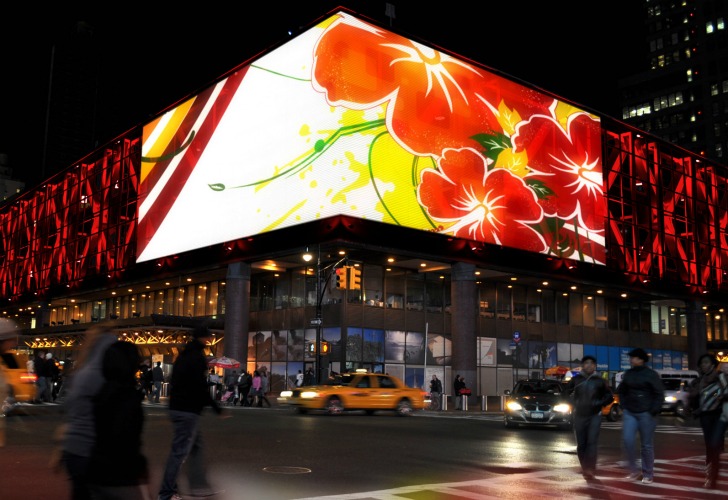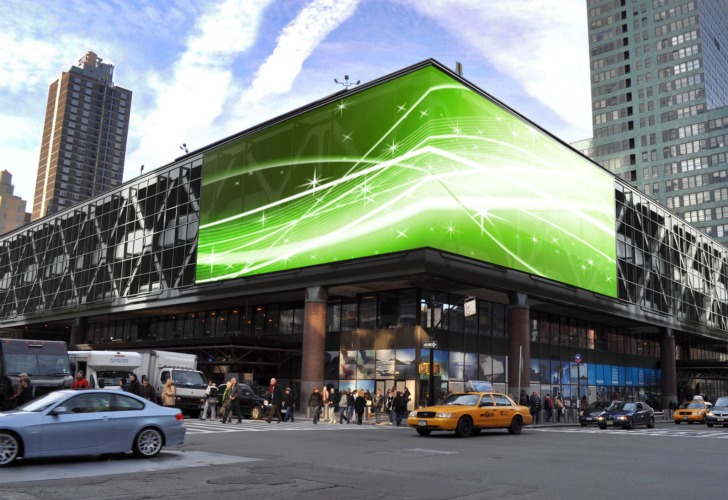

1. What Is 3D LED Display?
3D LED screen is a display that allows the display of 3D effects that can be seen with the naked eye, without the need for professional glasses.
This screen offers extremely realistic 3D effects, can display the content perfectly and attracts the attention of passers-by.
To further explain what is 3D LED screen, it is a kind of innovative LED display combining both LED display technology, and 3D contents to create a much more impressive visual effect than traditional LED/LCD display.
1.1 What Is 3D OOH?
If you are interested in advertising, there may be a word you have already met: OOH advertising.
Out of home advertising (OOH) is a form of advertising that can be found outside of a consumer’s home. Traditionally this includes everything from billboards to bus shelters, benches, and everything in-between. If you see an ad outside of your home (and it’s not on your mobile!), then you are most likely looking at some kind of OOH ad.
What is OOH advertising?
OOH means ‘out of home advertising’, representing it can be found outside of a consumer’s home.
If you are outside your home, you are most likely finding some kinds of OOH advertising such as LED billboard, bus shelters, etc.
Therefore, 3D OOH is a new type of advertising which is rising up recently, taking the advantages of both extended coverage of targeted customers brought by OOH advertising, and also the ability of grapping people’s eyes immediately inherited by 3D billboard.
You can totally believe 3D OOH billboard can be your one of the best ways of advertising and educating.
1.2 What Are the Sizes?
Generally speaking, for the indoor screens, the screen size should be above 3sqm; for outdoor applications, the screens are often more than 100sqm, and the height from the ground at the bottom should not be more than 10m.
1.3 What Is the Appropriate Viewing Angle?
The best viewing angle is 45-degree diagonal position of the screen.
But as long as you are still at a reasonable viewing distance from the screen, you can still see the 3D visual effect.
1.4 How to achieve the Hologram 3D display?
Here are some recommended configurations:
Hardware (Screen):
1, high refreshment: ≥3840hz
2, High grayscale: ≥14bit
3, High dynamic contrast
4, Configure multi-graphics card
A professional decoder and 3D video source are also needed.
2. How 3D LED Display Works?
3D refers to three-dimensional space. Compared with the ordinary two-dimensional picture, 3D is more three-dimensional and realistic, giving the audience a sense of immersion.
The three-dimensional sense comes from the human visual system. The basic principle of 3D display is to use glasses or other devices to separate the content area for the viewer’s left eye and right eye, so that the two glasses get the images of the left eye and right eye respectively, and finally produce a three-dimensional feeling in the brain.
The current 3D technology can be divided into glasses type and naked eye type. Glasses-based 3D technology can be divided into chromatic aberration type, shutter type and polarization type (also called color division, time division and light division).
3D technologies can be divided into three types: lens arrays, barrier fences and directional light sources. The principle and imaging effect of each technique are somewhat different.
2.1 Glasses Type - Masking 3D Technology
The 3D display control scheme of LED full-color display is generally shutter-type 3D technology. Shutter type 3D mainly achieves 3D effect by increasing the refresh rate of the screen. By splitting the image into two frame by frame, forming the corresponding left and right eyes.
These two sets of pictures of, displayed in a continuous interlaced manner, the signal transmitter will control the left and right lens switches of the shuttered 3D glasses synchronously so that the left and right eyes can see the corresponding pictures at the right time.
Shutter 3D technology can keep the original resolution of the picture, support HD resolution display pictures, and can perfectly present the true full HD 3D display effect of LED full color display.
Solution for Glasses type 3D led display
1. LED full-color display, resolution can be customized, 1080P is the best
2. PC with discrete graphics card
3. One 3D video processor (Colorlight,Linsn,Novastar)
4. Several receiving cards
5. Special 3D glasses
6. HD 3D video
2.2 Naked Eye 3D LED Display
Naked eye 3D display is currently the most popular outdoor LED display option. Through the lenticular or slit to form multiple viewpoints to ensure that the viewer has visual differences between the left and right eye when viewing any external device, thus forming a naked eye 3D display effect.
The essence is a naked-eye 3D effect formed by a 2D LED display and specially produced 2D video content.
The 3D wave screen in the SM Building in Korea uses the shadows of the background as a static 3D reference line to give the feeling of moving waves breaking through the screen.
That is, the display folds the screen 90° and uses video material that conforms to the principle of perspective, with the left screen showing the left view of the image and the right screen showing the main view of the image.
When people stand in front of the corner to watch, they will see the object at the same time. The side and front of the camera shows a realistic three-dimensional effect.
In this post: How Do 3D Billboard Works? We explore the working principles of 3D billboards further in an simple way.
2.3 Are 3D Billboard Real?
Now, maybe you can answer the question: are 3D billboards real 3D?
The answer is absolute no. As the three-dimensional effect is created by the digital 3D images. There’s no physical element present with edges in making the visual image look unreal.
You can conclude 3D LED billboard actually are: LED billboard + 3D content.
3. How Much Does A 3D Billboard Cost?
The 3D LED screen price varies from thousands of dollars to hundreds of thousands of dollars based on size, location, specifications, and contents.
Moreover, designs like corner displays can generate additional costs. But do not forget to account the content production into the final costs.
Here we list some important factors:
3.1 Specifications of Screens
(1) Size
As you know, the larger the size, the higher the billboard cost.
For indoor LED 3D screens, the size should be above 3sqm; for outdoor 3D billboard, the screens are often more than 100sqm, and the height from the ground at the bottom should not be more than 10m.
(2) Protection level
For outdoor LED display, the IP65 protection level is the standard.
If you want to increase the ability to IP66 or even IP68, then higher production cost is reasonable.
(3) Visual performance
Brightness level, contrast ratio and grayscale are three factors that have a direct impact on the LED screen.
3.2 Production of 3D Contents
(1) Video complexity
The visual effects depend largely on the 3D contents.
It is obvious that the more complicated the content, the higher the production cost. Sometimes it is even costly as there are a large number of details that need to be achieved.
(2) Duration
This relates to video time and production time.
The longer the duration of the display materials, the more expensive they are.
And don’t forget to factor in production time to have a likely price in mind.
(3) Production complexity
Typically, there are five steps of production: requirements defined, planning, producing content, correcting screen, and finishing product acceptance.
Post time: Sep-26-2023

